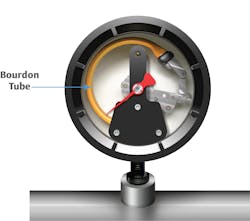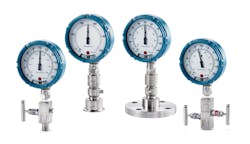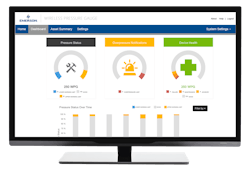Prevent pressure gauge failure using advanced digital and wireless gauge technologies
Pressure gauges are a common element in many industrial operations across a wide range of industries. They are simple devices used in processing systems anywhere a reading could help prevent pressure-related issues and failures. The most common form of pressure gauge deployed today is the Bourdon tube gauge — a mechanical measuring device that is long considered infinitely replaceable due to its low cost and frequency of failure. Unfortunately, these devices are susceptible to a number of precision and reliability issues. Process environments with extreme temperatures and corrosive applications can break the delicate mechanical components of Bourdon tube pressure gauges, causing their high failure rate. This, in turn, compromises process integrity, leading to costly downtime and significant safety risks to personnel.
Fortunately, there is another option. Innovations in electronic pressure gauges have eliminated the critical failure point of the Bourdon tube. These gauges use a highly robust solid-state sensor to convert real-time process pressures into electrical signals, which can be reported out to the user in multiple ways. To meet traditional form factors, the gauge features a standard analog-like gauge dial that uses a small internal motor to control needle movement during pressure changes. In addition to the physical dial readout, the gauge also broadcasts process pressure by way of WirelessHART. This enables real-time remote monitoring for the user without having to physically be at the measurement instrument.
Multiple barriers of process isolation and overpressure capabilities make these modern electronics a superior alternative to mechanical pressure gauges. The process industry does not have to accept the many pitfalls of these outdated devices any longer (Figure 1).
The hidden dangers of mechanical gauges: A critical failure point
Pioneers have been discovering new ways to measure pressure since the 1600s. The Bourdon tube gauge was invented in 1849 and launched into international adoption and success almost immediately. The world needed a sensitive and reliable device to measure pressure, and the Bourdon tube gauge delivered.These pressure gauges are used in applications across a spectrum of industrial manufacturing processes: petrochemical, hydrocarbons, food and beverage, energy, and wastewater management, to name a few. Yet, few operators question the safety and reliability issues that plague their mechanical components. When these devices are installed to monitor critical processes and safety systems, inaccurate readings and gauge failures can lead to catastrophic repercussions for operations.
Four common mechanical pressure gauge failures
Extreme temperatures
Operations can take place in some pretty extreme conditions, especially in the oil and gas sector. Superheated environments can damage pressure gauges when their temperature limits are exceeded. Wells in desert climates, for example, utilize pressure gauges that can break or become unreadable from the heat. On the other side of the coin are freezing temperatures, which are just as dangerous for mechanical gauges. Cold environments can cause the process fluid to freeze within the Bourdon tube and the glass screens to crack and break. Bourdon tubes with glycerin fill fluid are typically rated from 20ºF to 150ºF (-7ºC to 65ºC) ambient and 20ºF to 200ºF (-7ºC to 93ºC) for the process fluid temperature. Outside of these temperature ranges, damage to the gauges leads to less accurate measurements and the need to constantly replace them when they break.
Corrosion
Corrosive process fluids are a significant issue for Bourdon tubes as well. Manufacturers have limited choices for the type of material they can use to construct Bourdon tubes, so this flexible element is not built to withstand today’s caustic process fluids. In harsh process conditions, Bourdon tubes can develop cracks and holes that allow these corrosive fluids to leak out and into the pressure gauge. This leakage can then spill out through the indicator and escape into the environment. This situation is a major safety concern, but it could also lead to process downtime as expensive cleanup procedures take place.
Vibration and pulsation
Operations typically involve movement in pipelines where mechanical gauges are utilized. These vibrations and pulsations are the most common cause of mechanical gauge failure. Depending on the process and industry, plant managers might replace their pressure gauges as often as every few months due to process oscillation issues. Pulsating gauges are also notoriously difficult to read properly because the needle vibrates along with the shaking equipment. Breakages can occur in several components of the mechanical gauges — from the needle assembly to the internal gears.
Overpressure
Bourdon tube pressure measurement usually ranges from 5 pounds per square inch to 4 kilo pounds per square inch with an overpressure rating of 125%–150% of scale. Spikes in pressure over this rating can permanently damage Bourdon tubes and cause the device to rupture, posing a significant safety risk. As with the case of corrosive fluids, a ruptured tube creates a leak point. Not only will the gauge need replacement, but when process gas or liquid escapes into the environment, it will also expose personnel to dangerous conditions. It could mean expensive cleanup procedures and process shutdowns.
Concealed reliability issues and manual inspections
Another challenge for operators utilizing mechanical gauges is how difficult it is to know when one is not giving an accurate reading. Technicians performing manual inspections may report a working pressure gauge when, in fact, the internal mechanism is completely broken. The indicator may appear to be operating correctly even when, internally, it has a warped Bourdon tube or broken gears. Without clear malfunction indicators, technicians resort to things like tapping the gauge with a wrench to make sure the needle is not stuck in one position. This, of course, does not provide actual verification that there is not anything wrong with the pressure gauge or the accuracy of the reading.
Operators do not have time to perform in-depth manual inspections on every pressure gauge in a facility. If they are gathering key readings during their rounds, they take them quickly and then enter them into an asset management or data storage system. In addition to the errors from the pressure gauges themselves, all this manual transcription means there is a higher probability that incorrect data is being entered into the system.
How solid-state sensor technology outperforms traditional mechanical gauges
Bourdon tube mechanical pressure gauges come with a host of issues requiring limitless replacement. By switching these mechanical components with superior technology, operators can circumvent all of these problems. Proven solid-state sensing technology combined with wireless communication capabilities and an integral battery (with a 10-year life) provides up to 30 years of reliable readings, saving money, reducing maintenance and radically improving safety (Figure 3).
Electronic pressure gauges are designed to insulate the sensor from direct contact with the process by providing two barriers of isolation and keeping the process in the pipe. This protection curbs the effects of corrosion and prevents leakage. They can also function well across a much wider temperature range, delivering highly accurate readings in ambient temperatures from -40ºF to 185ºF (-40ºC to 85ºC) and for process fluid temperatures of -40ºF to 250ºF (-40ºC to 121ºC) with options to extend that range up to 698ºF (370ºC).
Piezo-resistive pressure sensor technology means that overpressure and vibrations are far less likely to damage the digital gauge. Electronic pressure gauges have an overpressure rating of up to 150 times scale range and a burst rating of up to 11,000 psi (758 bar). With fewer moving mechanical parts and a 5G vibration rating, they provide a much more stable pressure measurement in pulsating processes. More reliable readings and a higher degree of durability and robustness deliver a much safer environment and substantial cost savings over the life span of the gauge.
Wireless technology for a digital future
Electrical pressure gauge technology enables wireless connection to the digital ecosystem of a facility. By upgrading to wireless pressure gauges, plant managers gain real-time insights into each gauge across their entire operation, cutting down on operator rounds, optimizing maintenance schedules and enabling operators to quickly identify process anomalies before they become larger issues.
Pressure gauge readings are a critical component of plant safety and control. When readings can be verified in real time from a centralized control room, the ability to validate and optimize processes is streamlined (Figure 4). Advances in digital technology empower operators to drive peak performance and ensure safer process environments, all while providing more accurate and reliable measurement data in one easy-to-implement solution.
Michael Flesch is a global pressure product manager for Emerson’s Automation Solutions business in Shakopee, Minnesota, with responsibility for Rosemount pressure transmitters and gauges. He holds a Bachelor of Science in mechanical engineering from the University of North Dakota.
About the Author
Michael Flesch
Michael Flesch is a global pressure product manager for Emerson’s Automation Solutions business in Shakopee, Minnesota, with responsibility for Rosemount pressure transmitters and gauges. He holds a Bachelor of Science in mechanical engineering from the University of North Dakota.




